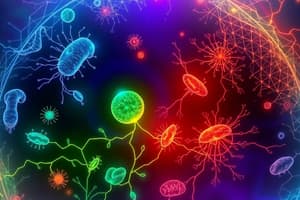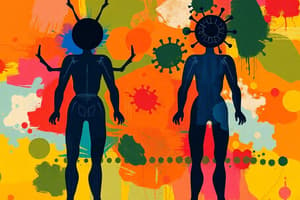Podcast
Questions and Answers
What is the initial step required for a pathogen to cause disease in a human host?
What is the initial step required for a pathogen to cause disease in a human host?
- Evading the body's adaptive immune response
- Accessing a portal of entry into the body (correct)
- Penetrating the surface of the skin
- Activating the complement system
The adaptive immune response differs from the innate immune response because the adaptive response involves:
The adaptive immune response differs from the innate immune response because the adaptive response involves:
- Rapid and immediate defense mechanisms
- Physical and chemical barriers
- The production of nonspecific responses
- Development of immunological memory (correct)
Which of the following is an example of a mechanical barrier in the first line of defense?
Which of the following is an example of a mechanical barrier in the first line of defense?
- The low pH of the stomach
- Mucociliary movement in the respiratory tract (correct)
- Lysozymes in tears
- Keratin on the skin
How do tight junctions between epithelial cells contribute to the first line of defense?
How do tight junctions between epithelial cells contribute to the first line of defense?
Which of the following is an example of a chemical barrier that protects the body from infection?
Which of the following is an example of a chemical barrier that protects the body from infection?
What is the significance of species specificity in genetic barriers?
What is the significance of species specificity in genetic barriers?
How do normal flora overcome the body's first line of defense to colonize a host?
How do normal flora overcome the body's first line of defense to colonize a host?
Which of the following is NOT considered part of the second line of defense?
Which of the following is NOT considered part of the second line of defense?
What is the primary goal of inflammation in the second line of defense?
What is the primary goal of inflammation in the second line of defense?
What is the role of vasodilation in the inflammatory response?
What is the role of vasodilation in the inflammatory response?
How does edema contribute to the inflammatory response?
How does edema contribute to the inflammatory response?
What is the role of chemotactic factors in the inflammatory response?
What is the role of chemotactic factors in the inflammatory response?
Which of the following accurately describes the process of diapedesis?
Which of the following accurately describes the process of diapedesis?
Which of the following is the correct order of stages in phagocytosis?
Which of the following is the correct order of stages in phagocytosis?
How do pyrogens trigger a fever?
How do pyrogens trigger a fever?
What is the role of interferon in the second line of defense?
What is the role of interferon in the second line of defense?
Which of the following statements best describes the function of complement proteins?
Which of the following statements best describes the function of complement proteins?
How do some microbes evade phagocytosis?
How do some microbes evade phagocytosis?
An individual contracts a viral infection. Which of the following innate immune responses is most likely to initially combat the virus?
An individual contracts a viral infection. Which of the following innate immune responses is most likely to initially combat the virus?
A patient presents with redness, swelling, heat, and pain in their lower leg. Which of the following processes is most likely responsible for these signs and symptoms?
A patient presents with redness, swelling, heat, and pain in their lower leg. Which of the following processes is most likely responsible for these signs and symptoms?
Which of the following mechanisms is part of the innate immune system's response to pathogens?
Which of the following mechanisms is part of the innate immune system's response to pathogens?
What is the primary function of lysozymes as a chemical barrier in the body's first line of defense?
What is the primary function of lysozymes as a chemical barrier in the body's first line of defense?
Which of the following best explains how mucociliary clearance protects the respiratory tract?
Which of the following best explains how mucociliary clearance protects the respiratory tract?
Why is the complement system considered part of the innate immune response?
Why is the complement system considered part of the innate immune response?
A researcher discovers a new bacterial strain that can colonize human skin without triggering an immune response. Which mechanism might the bacteria be using?
A researcher discovers a new bacterial strain that can colonize human skin without triggering an immune response. Which mechanism might the bacteria be using?
Flashcards
Innate Immunity
Innate Immunity
The body's initial, broad defense mechanisms that are present from birth, lacking specific targeting or memory.
Adaptive Immunity
Adaptive Immunity
Defense mechanisms that develop over time, targeting specific pathogens with immunological memory for faster response.
First Line of Defense
First Line of Defense
Physical and chemical surface barriers that prevent pathogens from entering the body.
Epithelium
Epithelium
Signup and view all the flashcards
Epithelial Surfaces
Epithelial Surfaces
Signup and view all the flashcards
Mechanical Barriers
Mechanical Barriers
Signup and view all the flashcards
Mucociliary Movement
Mucociliary Movement
Signup and view all the flashcards
Chemical Barriers
Chemical Barriers
Signup and view all the flashcards
Lysozyme
Lysozyme
Signup and view all the flashcards
Genetic Barriers
Genetic Barriers
Signup and view all the flashcards
Adhesins
Adhesins
Signup and view all the flashcards
Second Line of Defense
Second Line of Defense
Signup and view all the flashcards
Inflammation
Inflammation
Signup and view all the flashcards
Vasodilation
Vasodilation
Signup and view all the flashcards
Edema
Edema
Signup and view all the flashcards
Chemotactic Factors
Chemotactic Factors
Signup and view all the flashcards
Diapedesis
Diapedesis
Signup and view all the flashcards
Phagocytosis
Phagocytosis
Signup and view all the flashcards
Phagosome
Phagosome
Signup and view all the flashcards
Phagolysosome
Phagolysosome
Signup and view all the flashcards
Fever
Fever
Signup and view all the flashcards
Pyrogens
Pyrogens
Signup and view all the flashcards
Interferon
Interferon
Signup and view all the flashcards
Complement
Complement
Signup and view all the flashcards
Surface Proteins
Surface Proteins
Signup and view all the flashcards
Study Notes
- Chapter 15 is about Immunity
Overview of Body Defenses
- Numerous pathogens can cause disease in humans.
- Pathogens must access a portal of entry, penetrate the surface, and evade the body's defenses
- There are two broad categories of defense which are innate and adaptive
- The first line of defense consists of innate barriers
- The second line of defense consists of an innate immune response
- The third line of defense consists of an adaptive immune response
- Innate defenses: Memory doesn't exist, present at birth, and nonspecific.
- Adaptive defenses: Involve memory, specific, and happen simultaneously with innate defenses
The First Line of Defense
- Consists of barriers that are nonspecific
- The environment found on the surface can inhibit microbes from causing infection because of nutrients, temperature, and pH
- Barriers are structural, mechanical, chemical, and genetic barriers
Structural Barriers
- Epithelium is found on the surface both internally and externally.
- Two types of epithelial surfaces exist which are skin and mucous membranes.
- In both instances, the epithelium constantly undergoes mitosis and replaces sloughed layers.
- Microbes attached to the epithelium are lost
- Epithelial cells also have tight junctions between them
Mechanical Barriers
- Typically involve movement to physically remove microbes.
- Mucociliary movement is found lining the nose and throat, where microbes trapped in mucus are carried away by cilia to be coughed or swallowed.
- Fluid movement, like the flow of urine, saliva, or tears, helps continually flush microbes from the surface.
Chemical Barriers
- Consist of agents produced by the cells on the surface
- Keratin keeps the skin dry and waterproof.
- Perspiration is secreted by sweat glands and contains salt, which inhibits the growth of pathogens.
- Lysozymes defend against bacteria and are present in saliva and tears.
- Sebum is secreted by sebaceous (oil) glands, lowering skin pH to an inhibitory level for many bacteria.
- Similarly, pH is lowered in the stomach through the use of HCL.
Genetic Barriers
- Host is genetically immune to diseases of other hosts
- Microbes will not have the appropriate receptors or the ability to attack host cells
- Referred to as species specificity, for example: HIV versus FIV, Ebola virus, and heartworms.
Normal flora survival
- Normal flora make several adjustments to attach (adhere) to the surface of the body
- The attachment is with adhesins that bind to their complementary receptor molecules using a lock and key fit
Second Line of Defense
- Occurs when pathogens penetrate the skin or mucous membranes.
- Is part of the nonspecific innate immune response
- There are four components that involve the blood which are: inflammation, phagocytosis, interferon, and complement
Inflammation
- Inflammation ("itis") is a nonspecific response to tissue damage from various causes such as trauma, wounds, or burns
- Goals include removing the agent causing inflammation, keeping damage local, and allowing for healing to occur
- Prevent inflammation from spreading
- Characterized by redness, heat, swelling, and pain
- The fifth sign of inflammation is loss of function due to pain or swelling
- There are three sequential events that occur following an injury, including vascular changes, edema (local), and fever (systemic)
Vascular Changes
- Many chemicals released trigger dilation, including bradykinins, prostaglandins, and histamine
- Vasodilation can produce redness and localized heat
- Vascular changes delivers blood clotting proteins to site of injury as well as leukocytes
Edema
- Edema(swelling) occurs as the same chemicals released in vascular changes lead to increased permeability.
- Increased pressure is also attributed to the increased pressure of blood
- Swelling dilutes toxins, but can also apply pressure to nearby nerves
Inflammation Summary
- Inflammation comprises the combination of vascular changes and edema
- Neutrophils and monocytes are delivered to the site of infection
- Neutrophils and Monocytes are recruited by chemotactic factors and squeeze between cells of vessel wall and enter site of infection (Diapedesis)
- Phagocytosis occurs allowing for tissue repair and removal of pathogen (if present)
Phagocytosis
- Phagocytosis is where cells are called phagocytes are capable of engulfing a particle
- The process can be divided into five stages:
- Chemotaxis: Recognition of invader due to signal molecules on the microbe surface
- Ingestion: Membrane extensions surround microbe forming a phagosome
- Fusion: Lysosome fuses with phagosome creating a phagolysosome
- Killing: Digestive enzymes in lysosome destroy the microbe
- Elimination: Debris is discharged out of the cell
Fever
- Fever is a systemic factor
- Only occurs when microbe is present
- Results when pyrogens trigger the hypothalamus to increase the body's core temperature
- Two types of pyrogens exist
- Bacterial toxins (exogenous)
- Released by phagocytes (endogenous)
- Fever makes environment less hospitable for the pathogen, inhibiting growth of microbe, enhance phagocytosis
Chemical Defenses: Interferon
- The second line of defense includes chemical defenses
- Interferon consists of protein molecules released by host cells to nonspecifically inhibit the spread of viral infections
- It usually works by inhibiting reproduction of the virus, and is released by a cell once infected to protect neighboring cells
Chemical Defenses: Complement
- Complement includes a set of serum proteins designated numerically according to their order of discovery
- Complement has three primary effects
- C3a C5a contributes to inflammation
- C3b functions in opsonization
- C5b-9 participates in MAC/Cytolysis
Microbe Surface Proteins
- Some microbes produce surface proteins which interferes with direct contact with phagocytes, either due to similarity to host or by blocking receptors.
- These surface proteins can be unique however and allow for attack by the Third Line of Defense.
Studying That Suits You
Use AI to generate personalized quizzes and flashcards to suit your learning preferences.




